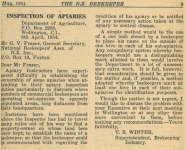This article from the NZ Bkpr magazine in 1954 was calling for beekeepers to make apiary identification a bit easier for AFB inspections. I haven't specifically followed the issue, but might do so to see what both the NZBkpr magazine and the NBA Executive minutes had to say about the suggestion...
In 1969 the heading of 'Identification of Apiaries' went into the Apiaries Act. That 1969 consolidated revision of the Apiaries Act was the last major legislative change. Prior to that, the record keeping allocated a code number for each apiary. The 1969 law changed to 'code' to refer to the beekeeper, and required using it as an identifier for each apiary.
I guess the only place this issue lives 'legislatively' any more is with the Pest Management Plan, which carried on the requirement after the demise of the Apiaries Act provisions (late 1990s).
In 1969 the heading of 'Identification of Apiaries' went into the Apiaries Act. That 1969 consolidated revision of the Apiaries Act was the last major legislative change. Prior to that, the record keeping allocated a code number for each apiary. The 1969 law changed to 'code' to refer to the beekeeper, and required using it as an identifier for each apiary.
I guess the only place this issue lives 'legislatively' any more is with the Pest Management Plan, which carried on the requirement after the demise of the Apiaries Act provisions (late 1990s).


